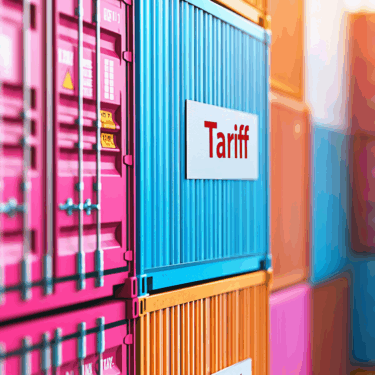The Future of Trade: Tariffs, Taxes, and Economic Trends
Three certainties amid global trade uncertainty
Uncertainty is the word de jour. For months, business leaders have lamented how difficult it is to plan, especially with unpredictable changes in trade tariffs. The latest US trade announcements don’t change that. Even with supposedly ‘locked-in’ import tariffs, past moves suggest little is permanent.
Many firms are now waiting for clarity before making any major moves. Why invest in expanding production or hiring new staff if you don’t know what the future trade outlook will look like or how import taxes might shift?
Against that turbulent backdrop, here are three truths you can hang your hat on:

1. Global trade is already falling.
There’s a narrative in the US and elsewhere that the global economy has withstood the test of trade tariffs-duties have been in place for months, and trade is still standing. But the reality is less rosy. After an initial rush by firms to beat tariffs, trade is tumbling.
While it’s still too early to show up in most official sources, our Maritime Trade Index, a daily gauge of global shipping, shows trade volumes are more than 2% lower than a year ago. In the US, seaborne imports have fallen by around 8%.
2. Tariffs are here to stay.
President Trump has had multiple opportunities to unwind tariffs. He could have used the pause in April after the initial ‘Liberation Day’ tariffs were announced to reset policy. He could have done the same when the pause was extended in July. Or he could have left the base 10% import tax intact in early August rather than forge ahead with economy-specific levies of up to 40%.
The fact that he let each of these opportunities pass confirms that tariffs will be higher for longer. And not just during Trump’s term. Tariff revenue is now baked into the US budget, making it difficult for policymakers of any persuasion to wean themselves off the windfall. Remember, President Biden kept Trump-era tariffs in place during his term.
It’s time to stop waiting for tariffs to fade and acknowledge they’re part of the baseline.
See how Oxford Economics can help you navigate the tariff changes
Get in touch3. Tariffs and politics are inseparable
US trade policy is serving multiple, sometimes competing, objectives, from national security and geopolitics to domestic political gain. Tariffs targeting China, Canada, Mexico, and Brazil are as much about projecting influence or shoring up support at home as they are about rebalancing trade. This mix of motives means US trade policy will be more volatile going forward.
Given these three realities – a world where trade is falling, tariffs are business-as-usual, and politics shapes economics, what can firms do to mitigate risks and get ahead?
For the latest reports on trade and tariffs, please visit our topic page.
Join our upcoming webinar to stay updated on the evolving landscape of US trade policy and get your questions answered by industry experts.
Stay ahead of trade turmoil – read our latest blog on five lessons every business should know.
Related content

Trade tracker – Tariff impacts continue to build
US tariff rates are climbing to levels not seen since the 1930s, with world trade expected to decline and inflation set to rise. What could this mean for global markets and economic growth?
Find Out More
Understanding Australia’s Goods Trade Dynamics in 2025
2. Explore Australia's goods trade dynamics, with rising exports and falling imports. Learn how global demand impacts the trade balance and future projections.
Find Out More
US tariffs and the uneven impact across cities in Europe and Asia
The latest US tariffs are reshaping global trade patterns, hitting some cities harder than others. From Germany’s auto hubs to China’s electronics exporters, which regions will weather the storm and which will struggle?
Find Out More
Five lessons for businesses navigating tariffs and trade turmoil
In a rapidly evolving global trade environment, businesses must stay ahead of changing tariffs and regulatory demands. Our latest blog offers practical guidance on navigating tariffs, understanding key trade strategies, and leveraging accurate HS code classifications to optimize your supply chain. Explore essential insights that will help your business manage trade uncertainty, ensure compliance, and unlock new growth opportunities.
Find Out More
Fresh tariffs redraw trade map
Trump’s latest tariffs favour Australia and Singapore with unchanged 10% rates, while Brazil faces a sharp 50% hike. India, Vietnam, and Bangladesh continue to face some of the world’s highest effective tariffs despite recent declines.
Find Out More
Tariffs bite as August deadline looms
Research Briefing The Future of Trade: Tariffs, Taxes, and Economic Trends Trade tensions escalate as new tariffs and policy uncertainty trigger sharp downturn in global shipping activity
Find Out More
Last-minute trade deal with the US leaves Eurozone outlook unchanged
We don't plan material changes to our Eurozone baseline forecast of 1.1% GDP growth this year and 0.8% in 2026 in response to the EU-US trade deal.
Find Out More
What are tariffs good for?
We built a forward-looking framework for analyzing how US tariffs achieve or undermine the various goals touted by policymakers.
Find Out MoreTags:

